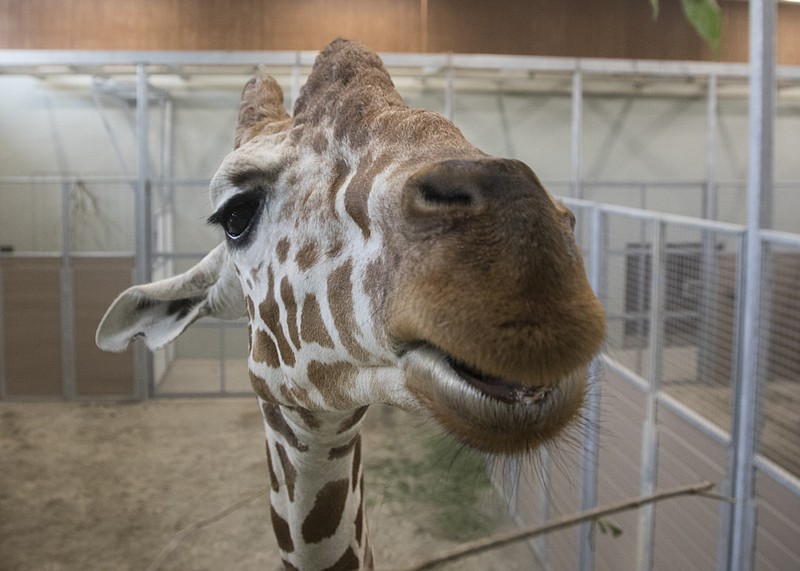With the debut of three reticulated giraffes this week, Chattanooga Zoo has fulfilled a tall order in its master plan, and the high-profile addition is just Phase 1.
Phase 2 is coming eventually, with plans to add "hoof stock like gazelles and really cool things like warthogs," but the arrival of the giraffes means "we're set for a while," said Dardenelle Long, CEO and president.
The city's shutdown during the coronavirus pandemic closed the zoo from March 17 to May 8, about seven and a half weeks. It has now reopened with crowd restrictions and other safety measures in place.
"We are struggling [financially] like everyone for sure, but hoping things will improve with giraffes," Long said. "Of course, we have to limit capacity, so it won't be as fast as we would like under different and safer circumstances."
The addition of giraffes has a much longer history for Long. She was hired as director in the 1980s when deteriorating conditions at the aging facility were running counter to a national shift toward natural habitats and conservation programs at larger zoos.
"When I took this job almost 35 years ago, there was not even a glimmer of a giraffe in my mind," Long said. "I never thought about doing anything except maybe to make life a little better for the animals in our care."
Reaching this milestone is something the community can be "very, very proud of," she said. "It's not just the money, but the time and energy and love and sacrifice that's been invested."
According to an online history, the facility that would later become Chattanooga Zoo was founded in 1937 with a 4- by 6-foot cage housing two rhesus monkeys. By 1942, increased animal acquisitions including lions, buffalo, alligators and bobcats had made the zoo one of the city's favorite entertainment attractions. By the 1960s, the facility had become more of a petting zoo with domestic farm animals.
As conditions for the animals worsened during the 1970s and early 1980s, the public began demanding change. The consensus: Improve or close. The support group Friends of the Zoo was founded in 1985 to serve in an advisory and developmental role, and an effort began to attain professional accreditation with the Association of Zoos and Aquariums, a milestone reached in 1998.
Building on that success, the zoo underwent unprecedented growth in the early 2000s. The property was expanded from 5 to 12 acres and several new additions opened, including the Gombe Forest exhibit, showcasing the zoo's chimpanzees, the Himalayan Passage, the largest red panda facility in the world, and the Cougar Express.
But the zoo was not without conflict. After a highly critical city internal audit in September 2010 and a spate of animal deaths in December 2010 and January 2011, the Friends of the Zoo took over management of the zoo. The negative publicity was compounded by the death of the zoo's most famous resident, Hank the chimpanzee. A necropsy later determined the 42-year-old chimp died of a heart condition.
Under Friends of the Zoo's direction, the second phase of Himalayan Passage was completed in 2006 with new exhibits for snow leopards and Hanuman langurs. A $4.2 million entrance complex, with a new ticketing area and gift shop, opened in 2008. Long said that signaled to the staff and board of directors that the zoo was ready for more.
"It was time to look at the master plan again," she said. "What can we do to take the zoo to the next level?"
The $2.5 million capital campaign to acquire the giraffes, dubbed "Reaching Great Heights," was financed through city, state and community funding, Long said. The project included adding an outdoor turnout space and renovating the old Warner Park fieldhouse into a very tall barn. Reticulated giraffes - a subspecies of giraffe native to the Horn of Africa - typically grow to about 18 feet.
"Reticulated" refers to the geometric patterns that identify the breed - a network of fine white lines on the giraffes' chestnut-colored coat.They have a relatively limited range across northern and northeastern Kenya, with small populations in the southern regions of Somalia and Ethiopia.
Reticulated giraffes are threatened by habitat deconstruction and poaching, according to the International Union for Conservation of Nature. There are only 15,780 individuals estimated to remain in the wild and are listed as an endangered species on the IUCN Red List.
Community activist Sonia Young, who serves on the board of directors, said giraffes have been at the top of many board members' wish lists for several years and is a "dream come true" for her. Some animals are too big to be practical for a zoo this size.
"Elephants are a no-no," she said. "This was the ideal animal."
The new giraffes - George, 5, Porter, 2, and Hardee Star, 17 months - lived together as a herd at the Freeport-McMoRan Audubon Species Survival Center in New Orleans before being relocated to Chattanooga. Long said the three bulls are still getting used to their new surroundings.
"They're still a little skittish," she said, "but it's great to see them just standing there looking majestic."
Because of the coronavirus pandemic, a grand-opening event to celebrate the giraffes' arrival and the Phase I opening of the new exhibit, Makazi Ya Twiga, will be scheduled later in the year.
The 14-acre Chattanooga Zoo (historically referred to as the Chattanooga Zoo at Warner Park) is accredited by the national Association of Zoos and Aquariums (AZA), assuring the highest standards of animal care and husbandry.
Find out more at chattzoo.org.
Email Lisa Denton at ldenton@timesfreepress.com.

